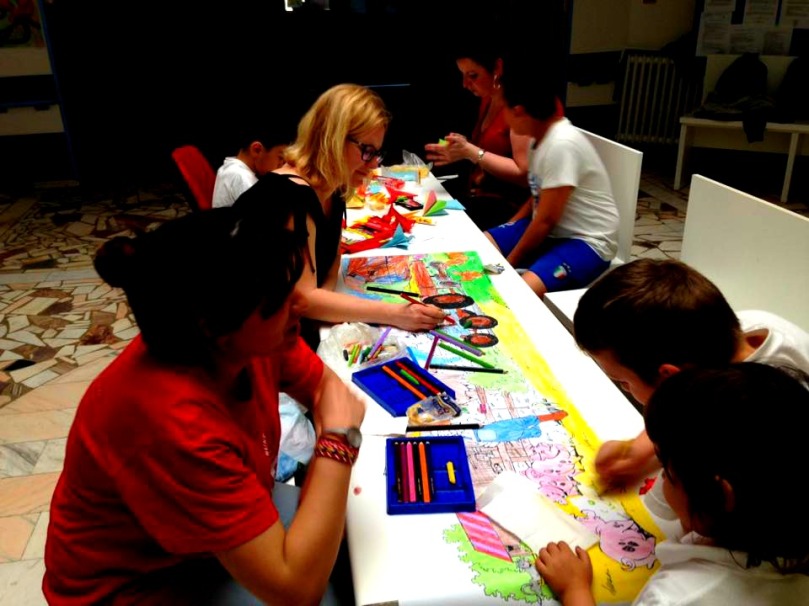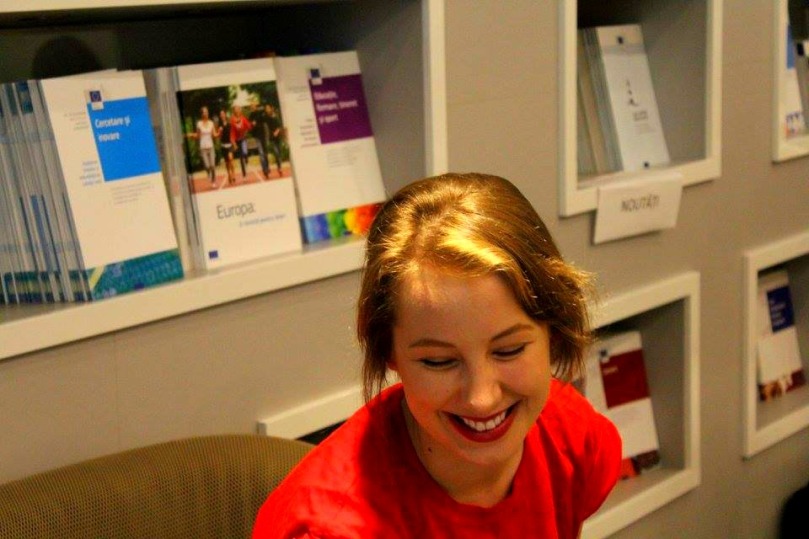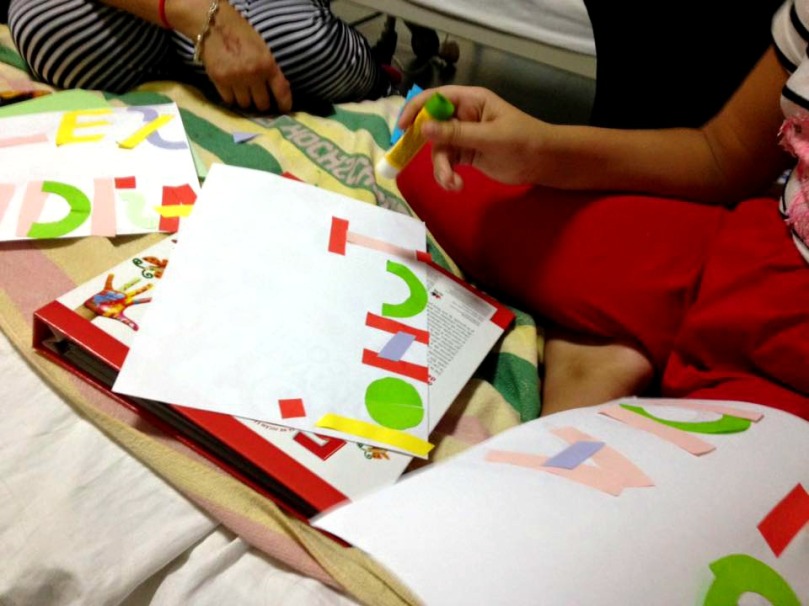“Una din cele mai importante activități ale acestui proiect o reprezintă animația clinică. Trebuie să recunosc că la început eram puțin speriată, dar în același timp am știut că pot să o fac. Nu am luat parte la animația clinică înainte să vin aici, dar a fost unul din motivele principale pentru care am ales acest proiect. Până atunci am fost oarecum conectată cu spitalele din probleme personale, dar această activitate este una specială și îți poate face ziua mai bună.
Așa cum am spus, înainte să încep, îmi era teamă de reacțiile și sentimentele pe care le-aș putea avea în situații dificile pe care le-aș putea întâlni în spitale la vederea copiilor mici și fragili; o experiență ca aceasta îți poate frânge inima și chiar asta se întâmplă, dar când ești acolo, în mijlocul lor, iar ei îți zâmbesc pentru că sunt mai puternici decât tine și pot avea mai multă energie decât tine… atunci, singurul lucru pe care îl poți face este să dai tot ce ai mai bun spre a-i face fericiți.
A fost puțin complicat la început din cauza limbii, dar cu toții vorbim aceeași limbă când vine vorba de zâmbete, îmbrățișări și gesturi frumoase. Frica lipsei de comunicare a durat mai puțin de două săptămâni și am devenit destul de repede încrezători, iar sentimentul de a fi folositor a fost singurul care a contat.
Primul obiectiv a fost să-i facem să se distreze. Cum? Am încercat cu baloane, apoi am înțeles că ei, copiii, sunt mai puternici decât noi; la finalul fiecărei vizite au în continuare energie și noi, voluntarii, suntem morți de oboseală! Așa că schimbăm strategia și căpătăm, cu timpul, noi competențe; am început să propunem activități mai liniștite și în același timp activități care să aibă un scop educațional sau artistic. Propunem ceva diferit de fiecare dată , aducem materiale variate și jocuri. Desigur, activitățile depind totuși de spitalul la care mergem și de ce fel de probleme au copiii.

Animația clinică este o experiență pe care oricine ar trebui să o încerce o dată în viață; emoțiile pe care le ai în timpul acesta sunt incredibile și imposibil de descris prin cuvinte. Acum sunt mai motivată și mă gândesc la viitor și la faptul că la finalul proiectului meu voi continua să fac animație clinică pe oriunde mă voi duce. Nu știu ce voi face după sau unde o să merg, dar dacă mă întorc în orașul meu natal, cu siguranță voi încerca să sugerez această idee spitalului de acolo.” (Silvia Tursi, Italia, Vitamn T+, A.C.T.O.R.)
“O mare parte din activitățile noastre din București implică vizitele la spitale pentru a ține companie copiilor și spre a-i învăța câte ceva. Mi se pare că la început, concentrarea era mai mult pe aspectul de distracție, probabil din cauza barierei lingvistice – nu ne era ușor să ne facem înțeleși așa că am compensat prin a fi cât mai gălăgioși cu putință – doar ca să avem atenția copiilor. Acum că limba nu mai reprezintă așa o amenințare – scrie Bibi care vorbește română ca un copil de cinci ani cu accent de moldoveancă – ne concentrăm mai mult pe partea educațională, învățând copiii despre cultura noastră, jucându-ne jocuri naționale ș.a.

Unele din cele mai frumoase experiențe în spitale au fost o amestecătură de jucuri cu aspecte educaționale – nu cred că ne mai este frică să fim lăsați singuri cu o grămadă de copii cu misiunea de a-i distra – ceva de care mă temeam îngrozitor înainte.
Provocarea spitalelor este că adeseori nu știm exact la ce să ne așteptăm când ajungem acolo. Poate fi o după-masă liniștită cu șase copii sau pot fi peste 30 de copii hiperactivi, câteodată suntem învăluiți de cadouri și dragoste, iar câteodată sfârșim acoperiți cu urme de dinți.
Per total, activitățile în spitale s-au îmbunătățit enorm și, personal, îmi plac foarte mult. Bucuria pe care o aducem lor nu poate fi măsurată, cum nu poate fi măsurată nici fericirea care ne împresoară după ce plecăm.” (Bibi Peet, Estonia, Vitamin T+, A.C.T.O.R.)
“One of the main activities of this project is clinic animation. I have to admit that at the beginning I was a bit scared, but at the same time I knew I could do it. I have never done clinic animation before coming here, but it was one of the reasons why I chose this project. Until now I have always been connected somehow to hospitals because of family reasons, but doing this is something special that can make your day better.
As I said, before starting I was a bit scared about my reactions and feelings in possible difficult situations I could find in hospitals, seeing little and fragile children in bad situations can break your heart and it does indeed, but when you are there and they smile at you because they are “stronger” than you and they can have more energies than you… then, the only thing that you can do is giving the best you can and make them happy.
At the beginning was a bit complicated because of the language, but we all speak the same language when it comes to smile and hugs and gestures. The fear for the lack of communication lasted less than two weeks, soon all of us became confident and the feeling of being useful prevailed.
First aim was make them to have fun. How? We tried with balloons, then, we understood that they were more powerful than us; in the end of each session they were still with a lot of energies and we, volunteers, were literally dead people! So we changed strategy and in time, having more competences, we started to propose quieter activities, but also with a didactic or artistic aim. Every time we propose something different, we bring a lot of different material and games and we play with them. Of course activities depend also from which hospital we go and which kind of problems children have.
Clinic animation is an experience that everyone should try once in their life because the emotions that you feel in doing it are incredible and impossible to describe in words. Now I am more motivated and I’m thinking about the future and about the fact that when my project will be over for sure I will continue to do it wherever I will go. I don’t know what I will do or where I will go, but if I come back in my hometown for sure I will try to suggest this amazing idea in the hospital of my town.” (Silvia Tursi, Italy, Vitamin T+, A.C.T.O.R.)

“A big part of our activities here in Bucharest involve going to hospitals to entertain and teach the children.
It seems to me in the beginning the focus was more on the entertainment aspect, probably because of the language barrier – it was not easy to make ourselves understood, so we compensated by being as noisy and over the top as possible – just to get and keep the attention of children. Now when the language is not such a problem – says Bibi who speaks like a five year old with Moldovan accent – we focus more on the educational side, teaching the kids about our cultures, playing national games and so on.
Some of the nicest experiences in hospitals have been a mixture of games with some teaching aspect – I don’t think any of us is afraid of being left alone with a bunch of kids and being told to entertain them anymore – something I used to be really afraid of.
The challenge of hospitals is that quite often we don’t know exactly what is waiting for us there when we go. It can be a calm evening with six kids, it can be 30+ super excited ones, sometimes we are showered with gifts and love, sometimes we end up covered with bite marks.
Overall, activities in hospitals have improved tremendously and I personally enjoy these a lot. The joy we bring there cannot be measured, also the happiness we feel after it.” (Bibi Peet, Estonia, Vitamin T+, A.C.T.O.R.)
